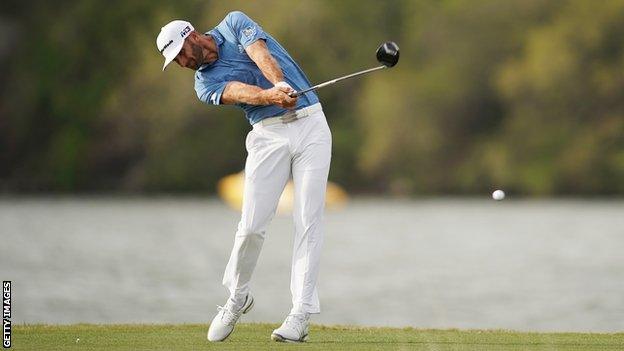Masters 2018: Why Augusta power games will not just be on the course
- Published
- comments

Dustin Johnson smashed a 489-yard drive at the WGC Match Play - and distance is dominating the minds of those who run golf
When the world's best players joust for the coveted Masters Green Jacket, Augusta will also stage a fierce contest to determine the shape of golf's future.
It is hard to remember a more eagerly anticipated opening men's major. The exploits of the world's best will dominate sporting headlines as Tiger Woods makes his Masters comeback against an exciting band of younger talent.
But as golf's most glamorous venue stages its most photogenic tournament with a plethora of enticing plot lines, it also provides a gathering point for the game's global administrators.
And top of their agenda is an increasingly divisive topic that goes to the heart of the sport at every level it is played. Golf is at a crossroads with a huge debate over which direction best secures its future.
The bosses meet in the wake of Dustin Johnson dispatching a drive a mammoth 489 yards at last week's WGC Match Play in Austin, Texas. And it is this issue of distance which dominates the minds of those who run the game.
It is clear the two bodies that set the rules - the St Andrews-based R&A and the United States Golf Association (USGA) - believe the time to act is fast approaching.
But it is equally apparent that those running the leading global tours have little enthusiasm to curb driving distances. Predictably, the leading manufacturers are even less keen.
It means the most powerful bodies in golf are on a collision course as they head to next month's meetings at the Augusta National clubhouse.
"We will see what happens in Augusta," PGA Tour commissioner Jay Monahan told BBC Sport. "But I don't know how robust the conversations will be."
Despite his diplomacy, they are likely to be pretty forceful. The R&A and USGA recently published their annual Distance Report,, external which showed an average increase of three yards on driving distances from 2016-17.
This might not seem much but it was a marked jump from the "slow creep" that had been detected in previous surveys.
"We have probably crossed that line in the sand and a serious discussion is now needed on where we go," said R&A chief executive Martin Slumbers.
"And you can rest assured that we are very serious to make sure what's right for golf."

USGA chief executive Mike Davis says expanding courses are 'increasing the cost of the game'
Mike Davis is the USGA's chief executive and has stated his views on what he sees as the detrimental effects of today's vast driving distances.
"The reality is this is affecting all golfers and affecting them in a bad way," he said. "These courses are expanding and are predicted to continue to expand. All it's doing is increasing the cost of the game. The impact it has had has been horrible."
It is a view shared by the likes of record 18-time major winner Jack Nicklaus and Gary Player, who won nine majors. Woods - a 14-time major champion - has also stated that the modern golf ball flies too far.
"It is a scientific problem, it's a biomechanical problem, it's an athletic problem," two-time Masters winner Ben Crenshaw told BBC Sport.
"The chorus is getting louder for the authorities to do something."
After a stellar playing career, Crenshaw has become a renowned golf course designer and is one of the most respected voices in the game. "The bottom line to me is if you build a golf course for these guys it's no fun for the average golfer.
"It is very difficult to put the two together. You don't want to build a golf course with eight to 10 different tee boxes because you don't want to compromise a certain hole by certain angles - so it's a problem," he added.
"Think about the billions of dollars that have been spent around the world retro-fitting golf courses. Think about the Old Course with the Road Hole tee being the wrong side of the wall, but it has to be done given the way the game has progressed.
"I do think you'll see more discussion about it as the Masters approaches."

Rory McIlroy hit the longest drive of his PGA Tour career at 409 yards during last year's WGC-Dell Technologies Match Play
At Augusta, the views of the modern generation of elite players will be presented via their tours. Rory McIlroy is the UK's biggest hitter and feels sorry that many layouts have been rendered obsolete for elite competition.
"Some golf courses can't stage the big events and that's a shame because some of the old traditional golf courses are the best and have the best architecture," the Northern Irishman told BBC Sport.
But he is proud of the prodigious distances he is able to generate and does not feel the golf ball travels too far. "I feel like being able to hit a long, straight drive is the same as being able to hole a six-foot putt under pressure," McIlroy added.
"It's a skill at the end of the day. If someone like me who is 5ft 9in and 73kg can hit the ball the same distance as a Dustin Johnson, who is 6ft 4in and is 20 or 30 kilos heavier than me, then everybody has the opportunity to do it.
"I pride myself on the fact that I hit the ball a long way for quite a small frame. It's something that I've worked on, just like I've worked on my short game and my putting. It's a skill that I've developed."
The European Tour is known to be vehemently opposed to any move to dial back the ball and the PGA Tour has shown no desire for such a move.
"We've had conversations that precede Augusta," Monahan said. "I know we are planning to have Mike Davis of the USGA to our player advisory council meeting in May and they will address our players."
For ordinary amateurs, modern technology makes the game more appealing. The average male drive flies 208 yards, eight yards longer than two decades ago, while women average 146 yards off the tee.
So one option is bifurcation - separate rules for elite golfers and humble hackers. But that destroys one of golf's central tenets: that it is the same sport played at every level.
Interestingly, though, a precedent is on its way. The newly published rule changes governing out of bounds include a more relaxed approach under a local rule for amateurs.
Is this the thin end of the bifurcation wedge, paving the way for a more radical dual approach to the game's governance of distance?
It is possible, but any such move faces genuine hostility. The PGA of America, which runs the US Ryder Cup team and looks after the country's club professionals, published a survey calling for the status quo to remain.
It invited its members to vote on three topics in the wake of the distance report.
Some 68% said they did not think distance increases are detrimental, 81% believed golf ball technology has been beneficial and 70% would oppose rolling back distances.
"Do you really think the rules-makers could make changes without the support of the main tours and the likes of the PGA of America? I don't think so," a very highly placed source at the European Tour told me.
"It'll be at Augusta where we start to thrash all of this out."
For those who feel courses are too long, that golf takes too much time to play, expanded land is too expensive to maintain and the art of shot-shaping has been lost, a rollback of the ball is vital.
But those who sell the game on its athleticism and the wow factor of the mighty hitting of McIlroy and Johnson take a different view.
David Abeles, chief executive of TaylorMade, says his company "opposes any potential rollback of product performance or bifurcation of the rules in any form as we believe these movements will be detrimental to the game at every level".
That view is echoed by rival firm Titleist. "Our analysis of the 2017 Distance Report affirms that the USGA and R&A have effective regulations in place to ensure the game's health and sustainability," said its boss David Maher.
With the sporting world watching, golf will present itself in rude health at next week's Masters. The storylines are fascinating.
But beneath the surface, remember the big question marks over its future sustainability. It is why the power games will not just be on the course at Augusta.
- Published2 April 2018

- Published12 March 2018

- Published24 January 2018
